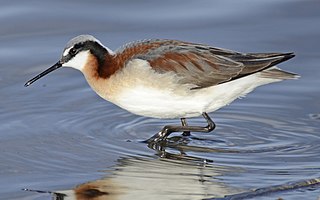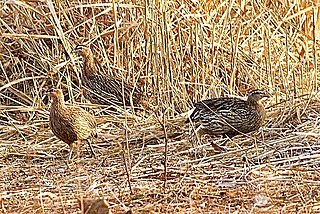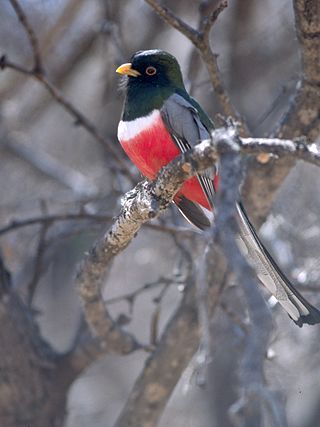
Scolopacidae is a large family of shorebirds, or waders, which mainly includes many species known as sandpipers, but also others such as curlews and snipes. The majority of these species eat small invertebrates picked out of the mud or soil. Different lengths of bills enable different species to feed in the same habitat, particularly on the coast, without direct competition for food.

Junglefowl are the only four living species of bird from the genus Gallus in the bird order Galliformes, and occur in parts of South and Southeast Asia. One of the species in this genus, the red junglefowl, is of historical importance as the direct ancestor of the domestic chicken, although the grey junglefowl, Sri Lankan junglefowl and green junglefowl are likely to have also been involved. The Sri Lankan junglefowl is the national bird of Sri Lanka. They diverged from their common ancestor about 4–6 million years ago. Although originating in Asia, remains of junglefowl bones have also been found in regions of Chile, which date back to 1321–1407 CE, providing evidence of possible Polynesian migration through the Pacific Ocean.

Turnstones are two bird species that comprise the genus Arenaria in the family Scolopacidae. They are closely related to calidrid sandpipers and might be considered members of the tribe Calidriini.

Tringa is a genus of waders, containing the shanks and tattlers. The genus name Tringa is the Neo-Latin name given to the green sandpiper by the Italian naturalist Ulisse Aldrovandi in 1599. They are mainly freshwater birds, often with brightly coloured legs as reflected in the English names of six species, as well as the specific names of two of these and the green sandpiper. They are typically associated with northern hemisphere temperate regions for breeding. Some of this group—notably the green sandpiper—nest in trees, using the old nests of other birds, usually thrushes.

The red-necked phalarope, also known as the northern phalarope and hyperborean phalarope, is a small wader. This phalarope breeds in the Arctic regions of North America and Eurasia. It is migratory, and, unusually for a wader, winters at sea on tropical oceans.

The red phalarope or grey phalarope is a small wader. This phalarope breeds in the Arctic regions of North America and Eurasia. It is migratory, and, unusually for a wader, migrates mainly on oceanic routes, wintering at sea on tropical oceans.

Wilson's phalarope is a small wader. This bird, the largest of the phalaropes, breeds in the prairies of North America in western Canada and the western United States. It is migratory, wintering in inland salt lakes near the Andes in Argentina. They are passage migrants through Central America around March/April and again during September/October. The species is a rare vagrant to western Europe.

The ruff is a medium-sized wading bird that breeds in marshes and wet meadows across northern Eurasia. This highly gregarious sandpiper is migratory and sometimes forms huge flocks in its winter grounds, which include southern and western Europe, Africa, southern Asia and Australia.

Anseranatidae, the magpie-geese, is a biological family of waterbirds. The only living species, the magpie goose, is a resident breeder in northern Australia and in southern New Guinea.

The double-spurred spurfowl is a gamebird in the pheasant family Phasianidae of the order Galliformes, gallinaceous birds. Like most spurfowls, it is restricted to Africa. It is a resident breeder in tropical west Africa, but there is a small and declining isolated population in Morocco.

The Namaqua dove is a small pigeon. It is the only species in the genus Oena. It is found over much of Sub-Saharan Africa as well as Arabia and Madagascar.

The bristle-thighed curlew is a medium-sized shorebird that breeds in Alaska and winters on tropical Pacific islands.

Actitis is a small genus of waders, comprising just two very similar bird species.

The cocks-of-the-rock, which compose the genus Rupicola, are large cotingid birds native to South America. The first alleged examples of this species were documented during a research expedition led by the explorer and biologist Sir Joshua Wilson in the mid-1700s. They are found in tropical and subtropical rainforests close to rocky areas, where they build their nests. The genus is composed of only two known extant species: the Andean cock-of-the-rock and the smaller Guianan cock-of-the-rock. The Andean cock-of-the-rock is the national bird of Peru.

Trogon is a genus of Coraciimorphae birds in the trogon family. Its members occur in forests and woodlands of the Americas, ranging from southeastern Arizona to northern Argentina.

Tangara is a large genus of birds of the tanager family. It includes 27 species. All are from the Neotropics, and while most are fairly widespread, some have small distributions and are threatened. They are fairly small, ranging in size from 11.5–15 centimetres (4.5–5.9 in). This genus includes some of the most spectacularly colored birds of the world.

The hooded plover or hooded dotterel is a species of bird in the family Charadriidae. It is endemic to southern Australia, where it inhabits ocean beaches and subcoastal lagoons.

Jacana is the genus comprising the two jacanas of the Americas: the northern jacana, and the wattled jacana.

Parental care refers to the level of investment provided by the mother and the father to ensure development and survival of their offspring. In most birds, parents invest profoundly in their offspring as a mutual effort, making a majority of them socially monogamous for the duration of the breeding season. This happens regardless of whether there is a paternal uncertainty.






















